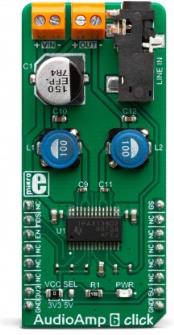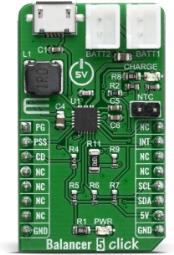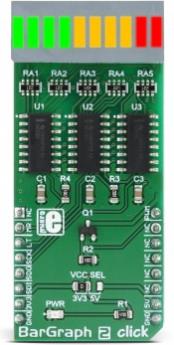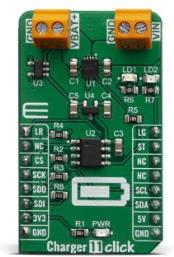Search
Search for "click":
(Click here to search this entire website for "click" with Google.)
 |

|
|
Audio Amp 6 click is a mono/subwoofer audio amplifier, capable of delivering up to 18.5W per channel with the 4? load. It is based on the TPA3138D2, a class-D integrated amplifier, which utilizes a highly efficient switching scheme. With about 20mA in idle mode, it allows for longer operation and improved thermal performance, making it a perfect choice for various battery-powered applications. Advanced EMI Suppression with Spread Spectrum Control allows using ferrite bead filters instead of bulky inductors, still maintaining the required EMC levels. The TPA3138D2 IC is equipped with a set of protection features, allowing a reliable operation.
Audio Amp 6 click is supported by a mikroSDK compliant library, which includes functions that simplify software development. This Click board™ comes as a fully tested product, ready to be used on a system equipped with the mikroBUS™ socket.
|
|
|
|
 |

|
|
Balancer 2 Click is an overvoltage protection device for a 2-series cell lithium-ion battery. Click contains two separate overvoltage battery detection circuits and automatic cell imbalance correction. It can be used for various applications, power tools, portable equipment, and instrumentation, to energy storage systems (ESS), while providing the output voltage at the same time. By utilizing an externally connected power supply, it can charge 2-cell Li-Ion batteries.
The Click board™ is supported by the mikroSDK compliant library, which includes functions that simplify software development. The Click board™ comes as a fully tested product, ready to be used on a system equipped with mikroBUS™.
|
|
|
|
 |

|
|
Balancer 3 Click is overvoltage protection device for 2-series cell lithium-ion battery packs that incorporates a high-accuracy precision overvoltage detection circuit and automatic cell imbalance correction. It can be used for various applications, ranging from smartphones, notebook / laptops, power tools, portable equipment and instrumentation, to energy storage systems (ESS), while providing the output voltage at the same time.
The Click board™ is supported by the mikroSDK compliant library, which includes functions that simplify software development. The Click board™ comes as a fully tested product, ready to be used on a system equipped with mikroBUS™.
|
|
|
|
 |

|
|
Balancer 5 Click is an intelligent 2-cell Li-Ion battery charger, system power manager, and a battery fuel gauge Click board™. Balancer 5 click is based on BQ25887 controller which has some extra features enabling charging without too much hassle. As a system power distributor, it can supply up to 3.3A to a connected battery. By utilizing an externally connected USB power supply, it can charge a 2-cell Li-Ion battery. A dedicated power management IC with the optimized smart power control allows very efficient management of the available power.
The Balancer 5 click is supported by a mikroSDK compliant library, which includes functions that simplify software development. This Click board™ comes as a fully tested product, ready to be used on a system equipped with the mikroBUS™ socket.
|
|
|
|
 |

|
|
BarGraph 2 click is a 10-segment bar graph display click, which uses a high-quality, multicolor bar graph LED display. The bar graph display is a very popular device for displaying various properties, whether it be an audio level, current/voltage level, position of the encoder, and generally any property that can be displayed in a form of a bar graph. The segments of the onboard bar graph LED display are bright and uniformly colored, providing a nice and clean visual feedback. |
|
|
|
 |

|
|
BarGraph 3 click is equipped with a five-segment LED bar graph display, notable for its strong and uniform illumination of the segments. Each segment consists of three internal LEDs with a common cathode, while the anodes of all LEDs are connected in a single point. This reduces the number of the display bar pins to just six. The common anode is connected to the PWM pin of the microbus via the P-type MOSFET, which can use the PWM signal from the microcontroller to change the intensity of the display. The fact that there are as many as three LEDs per segment makes the segments evenly illuminated, and the red color of the light on the dark background makes segments clearly visible.
It comes in the package which also includes the mikroSDK™ software and a library with all the functions. The Click board™ comes as a fully tested and approved prototype, making it a reliable device ready to use on the development board.
|
|
|
|
 |

|
|
Bluetooth2 Click features the BLUEGIGA WT41 Bluetooth 2.1 module with an operating range of 1000m (between two WT41 modules). It is equipped with iWRAP firmware which enables users to access Bluetooth functionality with simple ASCII commands delivered to the module. It supports up to 14 Bluetooth profiles. The board is ideal for developers who want to integrate the Bluetooth wireless protocol with a limited knowledge of Bluetooth and RF technologies. It uses four UART interface lines and is designed to use a 3.3V power supply only. |
|
|
|
 |

|
|
Buck-Boost click™ features LTC3129-1, a buck-boost DC/DC conversion integrated circuit from Linear Technology®. The click supports a wide input voltage range and can output eight discrete regulated output voltage levels, selectable by the digital output voltage selection pins, ranging from 2.5V to 15V.
The main features of this converter are its very low noise and low ripple at the output, as well as very high regulating efficiency and low quiescent current. Those features make the Buck-Boost click a perfect solution for the regulators and post-regulators for harvested energy, solar panel post-regulators/chargers, rechargeable battery output voltage regulators, wireless low noise applications and similar. |
|
|
|
 |

|
|
Cap Extend click is a mikroBUS add-on board with a SEMTECH SX8633 low power, capacitive button touch controller. It has 12 pins for connecting capacitive inputs (either touch-buttons or proximity sensors). Any sort of conductive object can be used as an input. Additional 8 GPIO pins, available on the side-edges of the board, can be used as LED drivers. The SX8633 IC integrates a 10 bit ADC - a resolution high enough to support a wide variety of touch pad sizes and shapes to be used with the click. Cap Extend click communicates with the target MCU through the mikroBUS I2C interface, with additional functionality provided by RST and INT pins. Designed to use a 3.3V power supply only. |
|
|
|
 |

|
|
Charger 11 Click is a LiFePO4 (lithium iron phosphate) battery charger. This click can be used for Low-Cost LiFePO4 battery chargers, or Power Tools, toys, backup energy storage solutions, etc. Charger 11 is based on MCP73123T controller which has some extra features enabling charging without too much hassle. This click board has charging current control which uses SPI interface through MCP4161 IC, which is an 8-bit digital potentiometer. For battery voltage monitoring this click board uses MCP3221A5T analog to digital converter through I2C interface. On the board, there is a Power LED and two extra LED's which can be used for charging indications.
Charger 11 click is supported by a mikroSDK compliant library, which includes functions that simplify software development. This Click board™ comes as a fully tested product, ready to be used on a system equipped with the mikroBUS™ socket.
|
|
|
|
 |
|
<< First
< Previous
Next >
|
|

